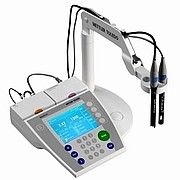Perform a pH meter measurement
Expected measurement accuracy
The accuracy of your measurement is influenced by different factors such as the accuracy of the buffers used for calibration, whether or not temperature compensation is used, if the right electrode is used for the particular sample measured, if the electrode has been given enough time to equilibrate and if the correct endpoint/measurement point is used in the meter, to mention just a few. When great care is taken with the measurements an accuracy of ± 0.05 pH units should be achievable.9 easy steps to ph measurement success
This guide assumes that a combination pH electrode is used. If separate pH and reference electrodes are used, ensure that you always put the electrodes in the same solution during measurements. Also ensure that both electrodes are connected to the pH meter.- Calibrate the pH meter using the appropriate buffer
- Pour enough sample solution into a measuring beaker so that the level of the sample is above the junction of the electrode.
- Make sure that either the temperature of the sample is known or that it is measured during the pH determination with an internal or external temperature sensor.
- Gently stir the sample and dip the pH electrode into the solution.
- If the temperature of the sample and the electrode are very different, ensure that the measurement drift caused by the temperature gradient has stopped before taking the pH reading.
- Press the measurement button on the pH meter and wait until a stable endpoint has been reached.
- Take the electrode out of the solution and rinse with distilled or deionized water.
- For additional samples repeat steps 1– 6 until all samples have been measured.
- After measurement, rinse the electrode with distilled or deionized water and store it in a wetting cap filled with reference electrolyte.
| Find out more about our range of ph meters | More advice on ph meters | |
  |  |
Source of article: A Guide to pH measurement by Mettler Toledo

